Table of Contents

Occupational accidents may happen to anyone, especially those working at significant heights like building constructions. Luckily, wearing work safety harnesses can protect you from falling injuries.
This equipment frees you from having to grip objects for balance and allows you to land safely. It also gives you confidence when doing tasks on skyscrapers instead of always worrying about sudden falls. It includes only a full body harness attached to a lanyard, so you can perform tasks with 2 hands freely.
If you are looking for a comprehensive guide on how to use safety harness and lanyard properly, without further ado, let’s get started.
What is a Lanyard Used for?
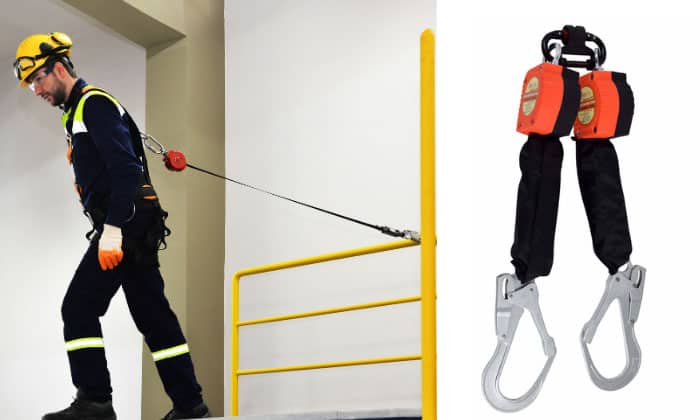
Do you know how to define lanyard? A lanyard is a resilient rope that is an indispensable part of the fall protection system. With connectors at 2 ends, you can connect one end to safety harness anchor points and tie off a safety harness or body belt, then link the other end to a braking tool or lifeline.
The purpose of a lanyard is to allow you to land safely and limit your working areas to avoid high-risk locations. Each item has a different maximum weight capacity holding you securely and reducing the force applied to you, and protecting anchor points.
To minimize this force, we’d highly recommend you use double lanyard safety harness when moving between multiple anchor points. It has two lines for tying off, so you can remain attached to an anchor at all times.
Step-by-step to Use Safety Harness and Lanyard
Step 1: Select a lanyard with a proper fall distance.
01 Shock-absorbing
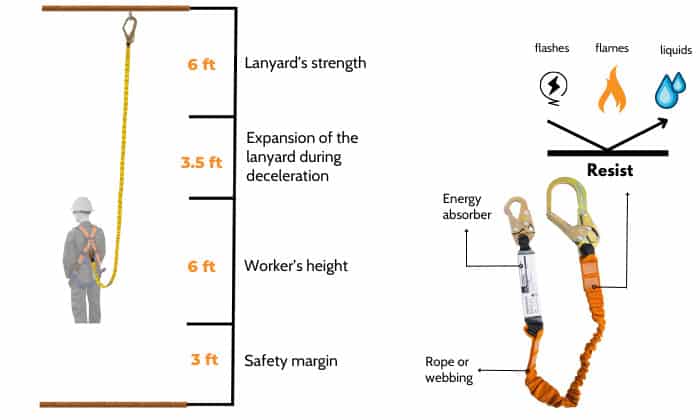
Shock-absorbing harnesses are common in many industries, since they can resist arc flashes, flames, sparks, and liquids, depending on the design. They have two end connectors, an energy absorber, and a rope or webbing.
The minimum height to wear safety harness with a shock-absorbing lanyard is 18/5 feet, which includes the below elements:
-
- Lanyard’s strength: 6 feet
- Expansion of the lanyard during deceleration: 3.5 feet
- Worker’s height: 6 feet, including a 1-foot harness stretch and 5 feet from your feet to the D-ring
- Safety margin: 3 feet
02 Self-retracting (SRLs):
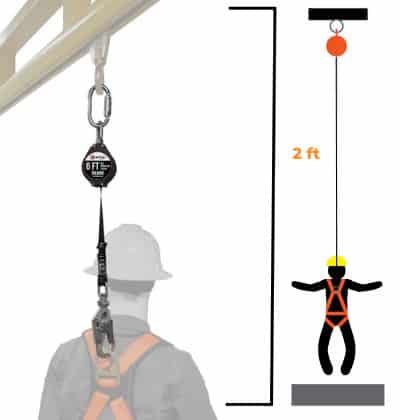
This type is equipped with an internal braking force and enables you to fall from around 2 feet. SRLs retract automatically and quickly to stop a fall mid-way. The most significant feature of SRLs is a non-slack rope for receding back into a casing.
03 Positioning lanyard
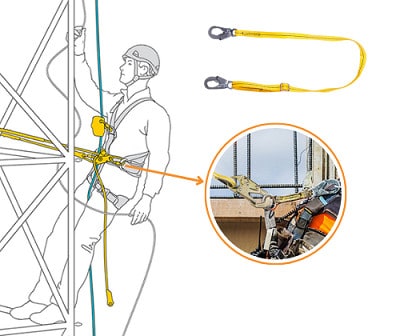
This type is attached to your side D-rings to keep you in place with its limited lengths and applies to situations where the fall is up to two feet. Hence, you can’t move around beyond its lengths.
Other considerations
- Choosing suitable materials for a safety harness with double lanyard and others ensures the equipment won’t be ruined quickly. Polyester is less vulnerable to mold than nylon, for example.
- Some tops of new buildings aren’t constructed with anchor points, but the anchors are placed at your feet instead; hence, you should use a 12-foot lanyard instead of a 6-feet one to ensure your security.
Step 2: Choose an appropriate harness.
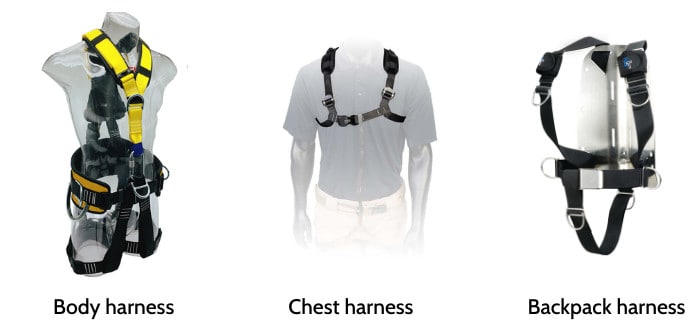
There are numerous types of safety harnesses out there. You should make sure your safety belt lanyard is compatible with them.
- Body harness: Its straps are worn around your shoulders, chest, waist, and legs, acting as supportive equipment when you work on towering distances or climbs. It is constructed with a dorsal D-ring in the middle of your shoulder blades to connect to the lanyard for safety harness.
- Chest harness: Wear it around your chest and buckle its two ends with a connector on your back, similar to using harnesses for dog.
- Backpack harness: This kind is designed with 2 straps for your shoulders and a strap for your chest. You can use it comfortably without worrying about falling down while working.
Step 3: Inspect the lanyard and harness.

Bear in mind to inspect a harness before using it to ensure you don’t face any issues due to damaged straps and hardware. Here are the components you shouldn’t skip when checking the harness with lanyard:
- Hold the dorsal D-ring on the back, elevate it, then shake it to allow the straps to droop.
- Check the webbings to make sure they aren’t cut, worn-out, and damaged. You need to examine their stitches as well, since loose stitches will increase the danger of falling.
- The hardware, including buckles, grommets, D-rings, plastic loops, and others shouldn’t be bent, cracked, or chipped. Unfasten the buckles for easy checking and putting them on later.
- Every lanyard consists of a label system; the information you need to check is: the latest inspection date, manufacturing information, length, material, allowed fall clearance, arrest strength, model, and serial numbers.
- If you find any knot on the lanyards, release it to avoid shortening its length. Aside from that, D-ring lanyards and L-hooks need to be examined as well to ensure they can connect to harnesses securely.
Step 4: Correct way to wear harness
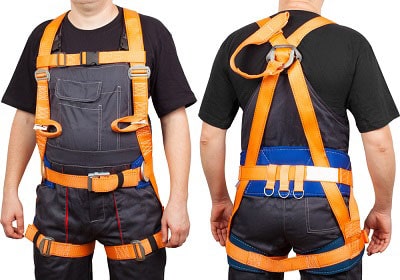
Now, it’s time to put the safety harness on. We’d highly recommend you wear the harness in this order.
- Shoulders: Wear the harness on your shoulders in the same way you don a jacket. Remember to position the dorsal D-ring in the middle of the shoulder blades.
- Legs: Leg straps can be designed with different buckle types, including tongue buckles, pass-style buckles, quick-connect buckles, and parachute buckles. The straps should embrace your thighs snugly. Too tight straps cause trouble in standing up comfortably.
- Chest: The chest straps are unbuckled; now, you will fasten them while making sure their position is in the middle of the chest.
- Waist: Not all harnesses are equipped with waist straps, but if your harness has them, you need to connect them.
Step 5: Adjust the harness.
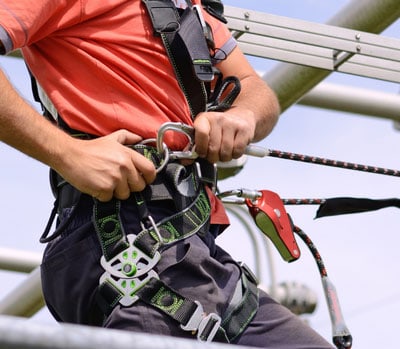
- You should feel comfortable and move easily when wearing a harness. Try placing your hands between your thighs and the straps. If you slide your hands back and forth smoothly, you put the harness on correctly.
- Put excess strap ends away by inserting them into loops to avoid fiddly movements.
- Have your colleagues check the harness to ensure the dorsal D-ring is located properly and there are no twisted straps.
Step 6: Install anchor point and lanyard.
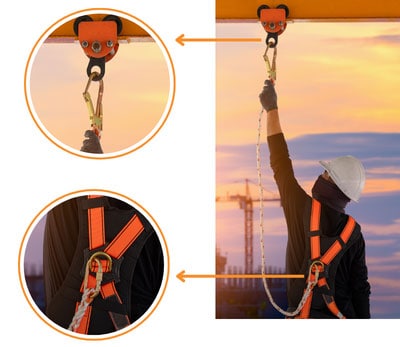
- The anchor points for the fall protection system shouldn’t be used for other purposes. They need to be installed securely to bear at least 5000 pounds. If you would like to install a new anchor, you will need the help of an expert. Otherwise, you can utilize originally constructed points.
- Now, install a lanyard for safety harness by connecting one end of the lanyard to the harness and the other to the anchor point. If you have a dual-leg lanyard, do this step twice. Note that the equipment you use should be brand-new to ensure its flexibility.
Harness Vs. Lanyard: What’s The Difference?
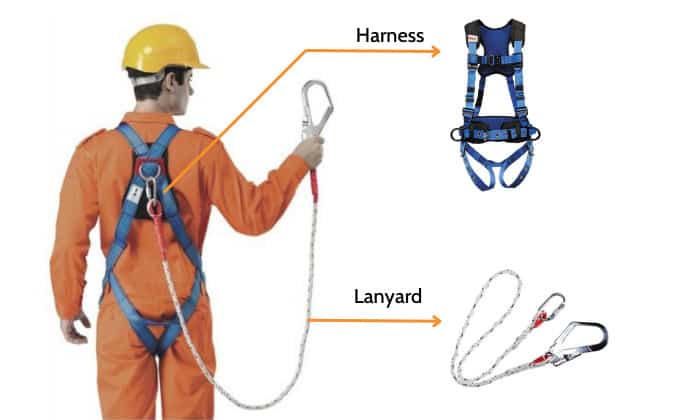
Components:
- The full-body harness includes shoulder straps, leg straps, and chest straps which are attached to a dorsal D-ring located on your back. It is also equipped with hardware: buckles, plastic loops, side D-rings, and more.
- A lanyard is a stretchable rope and cable made from polyester or nylon and designed with a D ring and L hooks.
Purpose:
- A harness is made to bear weight and slow down or stop falls. You can use a safety harness on a roof or climb as well.
- A lanyard is used to secure your harness to an immovable anchor point, structure, or lifeline to ensure you won’t hit the ground and land painfully. It doesn’t bear or distribute weight.
Conclusion
Your safety cannot be assured when you work at heights if you don’t know how to use safety harness and lanyard correctly. Via this post, we believe that you can learn steps to protect yourself from unwanted injuries.
You should select lanyards adaptable to not only your roof safety harness kit but also other equipment. Besides, don’t forget to check the safety harness training pdf or ppt from manufacturers to have the clearest guide, since producers design equipment differently. Stay safe!

This is Edward Manning, the editor in chief of Construction Informer. Quite a bit of my time is spent researching the market and interviewing experts in the field so that I can give you reliable information.
